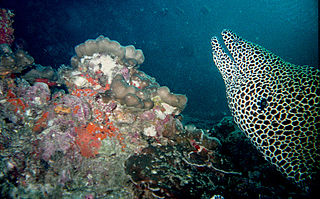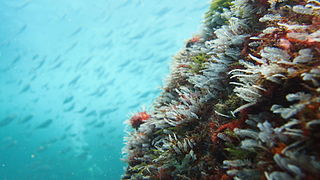
A biogeographic realm or ecozone is the broadest biogeographic division of Earth's land surface, based on distributional patterns of terrestrial organisms. They are subdivided into ecoregions, which are classified based on their biomes or habitat types.
A marine ecoregion is an ecoregion, or ecological region, of the oceans and seas identified and defined based on biogeographic characteristics.

The Arctic realm is one of the planet's twelve marine realms, as designated by the WWF and Nature Conservancy. It includes the coastal regions and continental shelves of the Arctic Ocean and adjacent seas, including the Arctic Archipelago, Hudson Bay, and the Labrador Sea of northern Canada, the seas surrounding Greenland, the northern and eastern coasts of Iceland, and the eastern Bering Sea.

The Tropical Atlantic realm is one of twelve marine realms that cover the world's coastal seas and continental shelves.

The Tropical Eastern Pacific is one of the twelve marine realms that cover the shallow oceans of the world. The Tropical Eastern Pacific extends along the Pacific Coast of the Americas, from the southern tip of the Baja California Peninsula in the north to northern Peru in the south.It also includes a number of islands and island groups, including the Galápagos, Revillagigedo, Cocos, and Clipperton. It is bounded on the north by the Temperate Northern Pacific realm, and on the south by the Temperate South America realm.

The Western Indo-Pacific is a biogeographic region of the Earth's seas, comprising the tropical waters of the eastern and central Indian Ocean. It is part of the larger Indo-Pacific, which includes the tropical Indian Ocean, the western and central Pacific Ocean, and the seas connecting the two in the general area of Indonesia. The Western Indo-Pacific may be classified as a marine realm, one of the great biogeographic divisions of the world's ocean basins, or as a subrealm of the Indo-Pacific.

The Central Indo-Pacific is a biogeographic region of Earth's seas, comprising the tropical waters of the western Pacific Ocean, the eastern Indian Ocean, and the connecting seas.

The Temperate Northern Pacific is a biogeographic region of the Earth's seas, comprising the temperate waters of the northern Pacific Ocean.

Temperate Southern Africa is a biogeographic region of the Earth's seas, comprising the temperate waters of southern Africa, where the Atlantic Ocean and Indian Ocean meet. It includes the coast of South Africa and Namibia, and reaches into southern Angola. It also includes the remote islands of Amsterdam and Saint-Paul, to the east in the southern Indian Ocean.

Temperate South America is a biogeographic region of the Earth's seas, comprising the temperate and subtropical waters of South America, including both the Pacific and Atlantic coasts of the continent and adjacent islands. It also includes the remote Gough Island and Tristan da Cunha in the South Atlantic Ocean.

The Eastern Indo-Pacific is a biogeographic region of the Earth's seas, comprising the tropical waters around island groups in the central Pacific Ocean. It includes most of Polynesia, except for New Zealand and the Kermadec Islands. It also includes the Marshall Islands and Kiribati from Micronesia. It adjoins the Central Indo-Pacific realm to the west, which encompasses Melanesia and the other island groups of Micronesia.

The Temperate Northern Atlantic is a biogeographic region of the Earth's seas, comprising the temperate and subtropical waters of the North Atlantic Ocean and connecting seas, including the Mediterranean Sea, Black Sea, and northern Gulf of Mexico.
The Magdalena Transition is a marine ecoregion in the eastern Pacific Ocean. It includes the coastal waters along the southwestern Baja California Peninsula, extending from Punta Abreojos in the north to Cabo San Lucas at the peninsula's southern tip.











